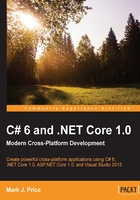
Talking about OOP
An object in the real world is a thing, like a car or a person. An object in programming often represents something in the real world, such as a product or bank account, but can also be something more abstract.
In C#, we use a class (usually) or a struct (rarely) to define each type of object. You can think of a type as being a blueprint or template for an object.
Encapsulation is the combination of the data and actions that are related to an object. For example, a BankAccount type might have data such as Balance and AccountName, as well as actions such as Deposit and Withdraw. When encapsulating, you often want to control what is allowed to access those data and actions.
Composition is about what an object is made of. For example, a car is composed of different parts such as four wheels, several seats, an engine, and so on.
Aggregation is about what is related to an object. For example, a person could sit in the driver's seat and becomes the car's driver.
Inheritance is about reusing code by having a subclass derive from a base or super class. All functionality in the base class becomes available in the derived class.
Abstraction is about capturing the core idea of an object and ignoring the details or specifics. Abstraction is a tricky balance. If you make a class more abstract, more classes would be able to inherit from it, but there will be less functionality share.
Polymorphism is about allowing a derived class to override an inherited action to provide custom behavior.